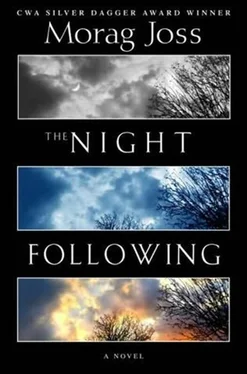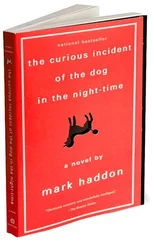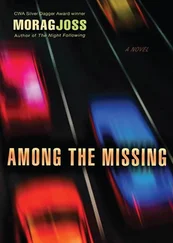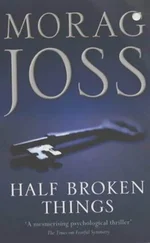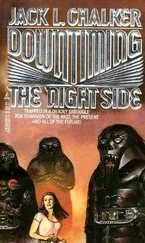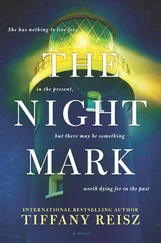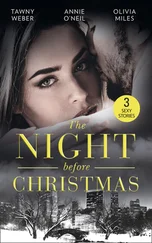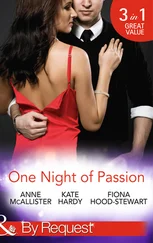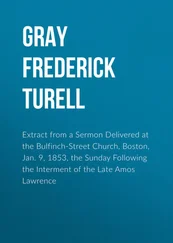The sun on my face wakes me up. There’s a tight ache around my ribs. The day is already garish but when I get out of the car to stretch my body, I discover it’s also windy and cold. By the side of the track, sparse and stemmy weeds dusky with exhaust fumes wave back and forth, and here and there in the ditch the meagre yellow stars of a wildflower dip among cigarette packets, bottles, and shreds of paper and buckled cans. Miles above us, a few birds fleck a giant, chaotic sky.
Arthur wakes in a bad mood. Of course, he says, peevish and flatulent, he will remember the turnoff out of Netherbarn Cross for Overdale, but we drive three miles too far before he admits in an injured voice that I have missed it. His stomach is upset; he wriggles and scratches and fidgets with the window. I turn the car around and we crawl back the way we came but still he can’t find the turnoff because, he says, he can’t be expected to recognize it approaching from the wrong direction. We persevere, but after more studying of the maps and the tattered hand-drawn directions from nearly forty years ago, twice he chooses the wrong track. One takes us into a farmyard; the other ends at a barred and padlocked brick building stuck with aerials and antennae, property of the electricity company, sitting at the base of a pylon.
It’s not as if you, Arthur says sniffily, as I reverse the car and we start to bump our way back to the road, were ever a natural at map-reading.
I’m too exasperated to reply so we drive on saying nothing for a while, back in the direction of Netherbarn Cross. We pass the same small garage we’ve seen half a dozen times; the situation is getting so desperate that I am steeling myself, if we have to drive past it again, to go in and ask for directions.
Still, he says, I suppose you’d better take a look.
I park at a disused turning that looks as if it might once have led to a hopeless golf course that never prospered. It’s a derelict little place that we’ve passed and repassed in the last hour, but while I’m peering at the map Arthur is staring hard out the window.
Those trees are new, he says eventually.
It seems we’re here. We’ve found it by accident. It’s the trees that threw him, a line of conifers on each side behind low, curving brick walls that also, he says, never used to be here. The old Overdale track has been transformed into an entrance, and the entrance is now in disrepair; in front of each of the two trees nearest the road stands a pair of upright, rusting metal struts, buckled and stricken. One set is quite bare and from the other hang the stiff plywood shreds of a sign long ago ripped away.
And another thing, Arthur grumbles, waving a hand behind him: How could I be expected to find it when everything else is so different? The garage never used to be there, either. And they’ve widened the road and stuck those things in the middle.
There are barriers between the two traffic lanes and a long white-hatched space in the road where coaches can wait before turning. His memory of the old hazardous junction is useless, and the old directions no longer make sense.
They’ve flattened out the bend, he says, aggrieved. No wonder I missed it. After all, you missed it, too, didn’t you?
I start the car again and we set off up the track. The posts of the brick entrance have fallen away and lie crumbled and biscuity on the ground, and across the walls zigzag fissures in the mortar skew the brickwork. There are gaps in the rows of white copestones. Where the conifers end, the way reverts to a country track through fields. A tall green line of weeds grows down the centre of it and swishes the underside of the car. Every few yards we drive over ruts that have been filled with stones or patches of tar, but not recently; thistles and dock sprout through puddles and cracks. I have to stop and get out to move a coil of wire and a sheet of corrugated iron out of the way, and about half a mile on we come across a burned-out, rusted car, tipped halfway into a field. The front wheels and bonnet are missing and its boot gapes open. Nettles stretch up through the engine.
Gradually we leave the tussocky fields behind. The hills on either side of the way begin to climb towards the sky. As they rise into slanting mounds and suave, tilting cones they assume new distinction and character; they acquire the presence, even sentience, of sculpture or of people standing peripherally and very still, alone or in deliberate clusters. Light brims over the shoulders of the eclipsed hills to the east and pours itself over the opposite side in cold, showy pinks and yellows. The track rises ahead and then dips, and in the distance disappears round a curve into the dark swell of a valley. I glance at Arthur. His eyes are running with tears and his mouth opens and closes wetly.
Nearly there, I whisper, and he nods.
After another mile or so the wide pebbly stream that is now running alongside the track veers away extravagantly. We round the next curve and Arthur cries out. I stop the car on the edge of an apron of pitted tarmac tatty with weeds and the mangled remains of benches and litter bins. The building before us is a small redbrick mansion with a miscellany of dark elaborate turrets and impractical chimneys and gabled windows, set into the hillside in front of a sparse plantation of twiggy shrubs and trees. Even derelict and vandalized, it looks pompous.
The whole place is surrounded by high chain-link fencing, bearing warning signs about trespass and the hazardous state of “these premises.” I leave Arthur weeping quietly in the car and walk the fence. I go as far as the ruin of a modern single-storey extension, not visible from the car, that abuts on the far side of the lodge. Here is where two sections of fencing have been forced apart and where, against the walls of the extension, fires have been set. Smoke stains snake up the boards nailed over the front doors as far as the asphalt overhang of the flat roof. The blistered, prefabricated panels under one of the windows have sheered off and now curl outward. Like all the others, this window had been boarded up, but now it’s a jagged dark rectangle. Traces of another fire on the ground underneath it reach as high as the sill. The window board itself, prised off and split and partly burnt, lies nearby in a bed of broken glass.
I’m stepping through the gap in the fence, twisting my way through a web of cut and buckled wire, when I hear excited screams from Arthur.
Ruth, Ruth! Quick! They’re still here!
I run back round to the car, but it’s empty. He shouts again. He’s way over by the front porch of the lodge, waving at me. I follow his gestures and he guides me along the fence to where it curves up the other side and around to the back. It’s adjoined clumsily to a wind-stricken tree whose trunk lists towards the ground, leaving an easy gap. Arthur beckons me through and I hurry down to him. The original pillared porch juts out squarely from the double front doors. There may have been benches set into the sides of the porch once, but they’re long gone. Some of the coloured diamond floor tiles are still in place under drifts of leaves and rubbish, and the walls are ornamented from top to bottom with panels of glazed brick set between carved pilasters and small empty niches. High on the walls a bas-relief frieze of acanthus and birds, bordered by a pair of deep ledges decorated like cake icing, runs along all three sides. Arthur is holding up a set of keys.
Knew they’d still be here! He’s clanking them on their ring and he’s gabbling and spitting with pride.
You remember? The secret spares! The porch ledge! Bill what’s his-name got them made in Matlock, remember? We’ll soon be in business, he says, thumbing through the keys and selecting one far bigger than the others. Aha, here’s the mortise. Proper locksmith’s key, that. Feel the weight of it.
Читать дальше
